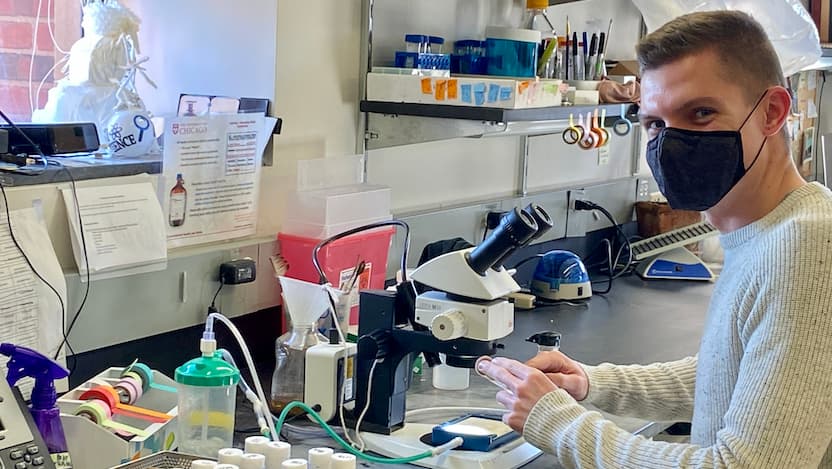Studying how cells move apart to move together

Imagine you are in a crowd of people, and the group needs to move from one place to another. What would you do? You might tell the people standing closest to you that you should all start walking in the same direction. Maybe they spread the word to the people nearest to them, until everyone in the crowd has received the information and you are all moving together toward your destination.
This might seem like a silly thought exercise, but groups of cells behave similarly when they move from one place to another in a process called collective cell migration.
Many of us are familiar with one form of collective cell migration, cancer metastasis. During metastasis, a group of cells from a primary tumor migrates through the body to a secondary site. In this and in other forms of collective migration, cells are in constant communication with each other to coordinate their movement. In Sally Horne-Badovinac’s lab at the University of Chicago, my fellow researchers and I are interested in understanding how cells communicate with each other to achieve efficient collective migrations.
Our lab uses the ovaries of fruit flies as a model. We chose this simpler system because it is easier to discover the basic rules governing how cells communicate during collective migration. These basic rules likely apply to more complex systems, such as cancer.
In fruit flies’ ovaries, eggs develop from multicellular structures called egg chambers. At the center of the egg chamber is a cluster of cells that will ultimately go on to form the egg. This cluster of cells is surrounded by a single layer of cells called follicle cells, and the follicle cells are surrounded by a dense meshwork of extracellular proteins. These follicle cells crawl on the extracellular protein matrix and collectively migrate around the central axis of the egg chamber in order to help shape the egg chamber into its proper form. If this is hard to picture, imagine if you had a bunch of hamsters running end-to-end on a stationary hamster wheel, so they are running in circles around the center of the wheel. How the follicle cells communicate with each other to migrate efficiently is a central question of our lab.
My project focuses on how two specific proteins found on the surface of follicle cells are used for communication between cells during their migration. These proteins, Sema-5c and PlexA, are required for migration and act as a ligand/receptor pair, where Sema-5c on the surface of one cell binds to PlexA on the surface of a neighboring cell, causing a response in the second cell. Unfortunately, we don’t know what this response is, how it promotes collective migration, or what other proteins this response might involve. I am working to understand the specific cellular response to signaling from Sema-5c and PlexA.
Luckily, we have a few clues. Sema-5c and PlexA are part of larger families of signaling proteins that were discovered several decades ago for their important role during the development of the nervous system. The semaphorin and plexin families of proteins — to which Sema-5c and PlexA belong, respectively — were originally found in the nervous system to act as repulsive cues, telling migratory neurons that are trying to find their way through the body that they are in the wrong place and need to go in the opposite direction.
I think Sema-5c and PlexA might be playing a similar role in follicle cells, where they act as a repulsive cue to tell cells to move away so they can move together in one direction. How would this work? Think again of the example of a moving crowd. Instead of telling people near you to walk in the direction of the destination, you could push them away from you. If everyone pushed their neighbors in the same direction, the whole crowd would start moving in one direction.
If Sema-5c and PlexA are acting as repulsive cues in follicle cells, what other proteins are required? Again, we turn to the nervous system. In cells of the nervous system, a protein called Mical disassembles the cell’s physical internal infrastructure, called the cytoskeleton. Assembly of the cytoskeleton outward from a specific edge of the cell will physically “push” the cell in the direction of assembly, causing it to migrate. The opposite is true as well: Disassembly of the cytoskeleton will prevent a cell from migrating in that direction. Think of the cytoskeleton during migration like a human inside a giant beach ball where whatever side you push on, the ball will roll in that direction. If Mical is able to disassemble the cytoskeleton in the same region of every cell, it could help direct the cells to all migrate in a similar direction.
I am currently exploring whether Mical has a similar function in follicle cells, and whether this function is specifically activated by Sema-5c and PlexA signaling. By using a combination of genetic approaches and microscopy, I hope that I will be able to uncover what responses Sema-5c and PlexA induce in cells, and what other proteins this response requires. By studying the humble fruit fly, our findings may eventually prove useful for other scientists studying collective migrations in more complex systems, like cancer metastasis.
